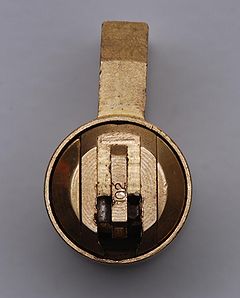BiLock EX
BiLock EX/NG
| BiLock EX/NG | |
 | |
| Name | BiLock EX/NG |
|---|---|
| Manufacturer | Australian Lock Company |
| Lock Type | Cylinder |
| Lock Design | Sidebar |
| Year(s) Produced | 1998 - present |
| Patent | US 6,681,609 |
| Related Locks | |
| BiLock BiLock QC | |
The BiLock EX (or BiLock NG, BiLock New Generation) is a UL 437-rated dual-sidebar lock made by Australian Lock Company. The BiLock EX uses twelve pins arranged in two rows of six. Each row of pins uses a separate sidebar located at 3 and 9 o'clock in the plug. The BiLock NG is easily identified by the U-shaped key and keyway.
The BiLock EX supercedes the earlier BiLock. It also comes in a interchangeable core format known as the BiLock QC.
Principles of operation
The BiLock uses two rows of six pin-tumbler pins and five sidebar finger pins. To open the lock, all pin-tumblers properly raised to a height that allows the side bar legs to retract into small holes located in the key pins. Every pin has a second, shallow hole drilled in it. This hole is deep enough to allow the pin to set under sidebar pressure but too shallow to allow the sidebar to fully retract.
BiLocks are unique because they contain no driver/top pins and therefore the lock has no traditional shear line. There are ? depths for pin-tumblers, allowing for ? theoretical key differs for each pin stack. The MACS for this lock is ? depths, giving the ? around ? real key differs. Master keying is available by using pins with wider sidebar holes.
The BiLock EX also has what is traditionally known as an interactive element in the key that was implemented to add an extra layer of security and extend the original patent of the lock. BiLock refers to this element as a "trigger" which is held between the two blades by the plastic key head. In its rest position the Trigger protrudes through a small opening in the key blade. As the key enters the keyway, the bottom of the keyway channel forces the front of the trigger upward into a lift pin. When the lift pin is raised, it drags a blocking bar up and out of the way of the right side bar, allowing it to retract.
Notes
- BiLock keys are cut then folded to create their U-shape.
Disassembly instructions
The BiLock EX is easy to disassemble, but the moving element uses a number of small components that need to be considered.
- Remove the cam or C-clip.
- Remove the plug from the cylinder. A plug follower is not needed because there are no driver pins.
- Remove the faceplate from the front of the lock to access the moving element and the pin chamber cover.
Vulnerabilities
The BiLock EX may be vulnerable to one or more of the following:
Notes
- The BiLock EX cannot be bumped because it is not a pin-tumbler lock.
Gallery
References
